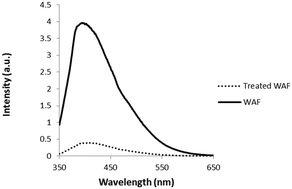当前位置:
X-MOL 学术
›
Environ. Sci.: Nano
›
论文详情
Our official English website, www.x-mol.net, welcomes your feedback! (Note: you will need to create a separate account there.)
Use of PVP-coated magnetite nanoparticles to ameliorate oil toxicity to an estuarine meiobenthic copepod and stimulate the growth of oil-degrading bacteria
Environmental Science: Nano ( IF 7.3 ) Pub Date : 2017-07-18 00:00:00 , DOI: 10.1039/c7en00257b Amjed Alabresm 1, 2, 3, 4, 5 , Seyyedali Mirshahghassemi 1, 2, 3, 4, 5 , G. Thomas Chandler 2, 3, 4, 5, 6 , Alan W. Decho 2, 3, 4, 5, 6 , Jamie Lead 1, 2, 3, 4, 5
Environmental Science: Nano ( IF 7.3 ) Pub Date : 2017-07-18 00:00:00 , DOI: 10.1039/c7en00257b Amjed Alabresm 1, 2, 3, 4, 5 , Seyyedali Mirshahghassemi 1, 2, 3, 4, 5 , G. Thomas Chandler 2, 3, 4, 5, 6 , Alan W. Decho 2, 3, 4, 5, 6 , Jamie Lead 1, 2, 3, 4, 5
Affiliation

|
Crude oil and its water-accommodated fractions (WAF) have the potential to cause catastrophic damage to aquatic ecosystems when released. A new nanomaterial (NM), composed of polyvinylpyrrolidone-coated iron oxide, has been successfully used to remediate oil-contaminated waters. In this study, the toxicity of these NMs, crude oil WAF, and their mixtures was evaluated using an acute toxicity assay based on the estuarine copepod Amphiascus tenuiremis. Results showed that the NMs had no significant effect on copepod survival up to concentrations of 25 mg L−1 over 4 days. For comparison, optimal oil removal from the aqueous phase was shown to be at 18 mg L−1 over 1 hour. WAF was highly-toxic to copepods (mortality 95 ± 5%). Mixing and magnetic removal of NMs within 1 hour of exposure to WAF resulted in a >90% reduction in toxicity compared to the control sample that contained WAF with no NMs. Addition of NMs to WAF at times up to 72 hours without magnetic separation also resulted in significantly reduced toxicity, suggesting that the physical form of the oil :
: NM mixture influenced toxicity. The addition of oil degrading-bacteria to WAF treated with NMs resulted in significant stimulation of bacterial growth relative to WAF without NMs, likely because of the input of additional available Fe and C sources. These initial data suggest that under realistic environmental conditions, these NMs could be added rapidly to oil spills in marine systems to reduce acute oil toxicity and increase oil degradation.
NM mixture influenced toxicity. The addition of oil degrading-bacteria to WAF treated with NMs resulted in significant stimulation of bacterial growth relative to WAF without NMs, likely because of the input of additional available Fe and C sources. These initial data suggest that under realistic environmental conditions, these NMs could be added rapidly to oil spills in marine systems to reduce acute oil toxicity and increase oil degradation.
中文翻译:

使用PVP包覆的磁铁矿纳米颗粒改善对河口中足底ben足类动物的油脂毒性并刺激油脂分解细菌的生长
原油及其含水部分(WAF)释放时有可能对水生生态系统造成灾难性破坏。一种由聚乙烯吡咯烷酮涂层的氧化铁组成的新型纳米材料(NM)已成功用于修复受油污染的水域。在这项研究中,使用基于河口co足类Am虫Amphiascus tenuiremis的急性毒性测定法评估了这些NMs,原油WAF及其混合物的毒性。结果表明,在浓度超过25 mg L -1的4天时间内,NM对on足类动物的存活率无明显影响。为了进行比较,从水相中去除的最佳油显示为18 mg L -1超过1小时。WAF对co足类动物具有高毒性(死亡率95±5%)。与不包含NMs的WAF的对照样品相比,在暴露于WAF的1小时内混合和磁力去除NMs可使毒性降低> 90%。在不进行磁力分离的情况下,最多72小时将NMs加入WAF也可导致毒性显着降低,表明该油的物理形式为 :
: NM混合物影响毒性。与不使用NMs的WAF相比,在用NMs处理的WAF中添加石油降解细菌会显着刺激细菌生长,这可能是由于输入了其他可用的铁和碳源所致。这些初步数据表明,在现实的环境条件下,可以将这些NMs快速添加到海洋系统的溢油中,以减少急性油中毒并增加油的降解。
NM混合物影响毒性。与不使用NMs的WAF相比,在用NMs处理的WAF中添加石油降解细菌会显着刺激细菌生长,这可能是由于输入了其他可用的铁和碳源所致。这些初步数据表明,在现实的环境条件下,可以将这些NMs快速添加到海洋系统的溢油中,以减少急性油中毒并增加油的降解。
更新日期:2017-09-14
 :
: NM mixture influenced toxicity. The addition of oil degrading-bacteria to WAF treated with NMs resulted in significant stimulation of bacterial growth relative to WAF without NMs, likely because of the input of additional available Fe and C sources. These initial data suggest that under realistic environmental conditions, these NMs could be added rapidly to oil spills in marine systems to reduce acute oil toxicity and increase oil degradation.
NM mixture influenced toxicity. The addition of oil degrading-bacteria to WAF treated with NMs resulted in significant stimulation of bacterial growth relative to WAF without NMs, likely because of the input of additional available Fe and C sources. These initial data suggest that under realistic environmental conditions, these NMs could be added rapidly to oil spills in marine systems to reduce acute oil toxicity and increase oil degradation.
中文翻译:

使用PVP包覆的磁铁矿纳米颗粒改善对河口中足底ben足类动物的油脂毒性并刺激油脂分解细菌的生长
原油及其含水部分(WAF)释放时有可能对水生生态系统造成灾难性破坏。一种由聚乙烯吡咯烷酮涂层的氧化铁组成的新型纳米材料(NM)已成功用于修复受油污染的水域。在这项研究中,使用基于河口co足类Am虫Amphiascus tenuiremis的急性毒性测定法评估了这些NMs,原油WAF及其混合物的毒性。结果表明,在浓度超过25 mg L -1的4天时间内,NM对on足类动物的存活率无明显影响。为了进行比较,从水相中去除的最佳油显示为18 mg L -1超过1小时。WAF对co足类动物具有高毒性(死亡率95±5%)。与不包含NMs的WAF的对照样品相比,在暴露于WAF的1小时内混合和磁力去除NMs可使毒性降低> 90%。在不进行磁力分离的情况下,最多72小时将NMs加入WAF也可导致毒性显着降低,表明该油的物理形式为
 :
: NM混合物影响毒性。与不使用NMs的WAF相比,在用NMs处理的WAF中添加石油降解细菌会显着刺激细菌生长,这可能是由于输入了其他可用的铁和碳源所致。这些初步数据表明,在现实的环境条件下,可以将这些NMs快速添加到海洋系统的溢油中,以减少急性油中毒并增加油的降解。
NM混合物影响毒性。与不使用NMs的WAF相比,在用NMs处理的WAF中添加石油降解细菌会显着刺激细菌生长,这可能是由于输入了其他可用的铁和碳源所致。这些初步数据表明,在现实的环境条件下,可以将这些NMs快速添加到海洋系统的溢油中,以减少急性油中毒并增加油的降解。



























 京公网安备 11010802027423号
京公网安备 11010802027423号